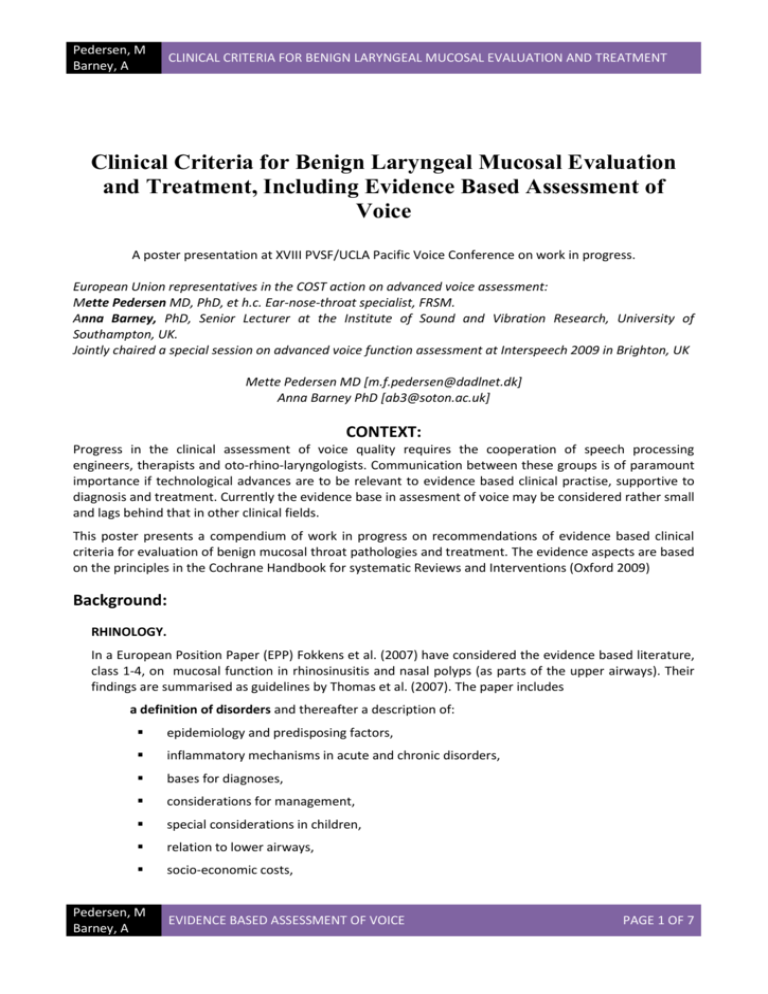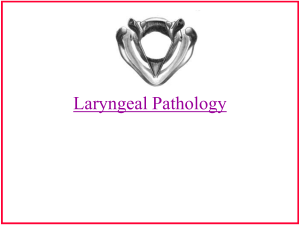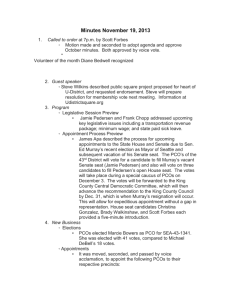Voice Measures Before and After Laryngeal Reflux Treatment
advertisement

Pedersen, M Barney, A CLINICAL CRITERIA FOR BENIGN LARYNGEAL MUCOSAL EVALUATION AND TREATMENT Clinical Criteria for Benign Laryngeal Mucosal Evaluation and Treatment, Including Evidence Based Assessment of Voice A poster presentation at XVIII PVSF/UCLA Pacific Voice Conference on work in progress. European Union representatives in the COST action on advanced voice assessment: Mette Pedersen MD, PhD, et h.c. Ear-nose-throat specialist, FRSM. Anna Barney, PhD, Senior Lecturer at the Institute of Sound and Vibration Research, University of Southampton, UK. Jointly chaired a special session on advanced voice function assessment at Interspeech 2009 in Brighton, UK Mette Pedersen MD [m.f.pedersen@dadlnet.dk] Anna Barney PhD [ab3@soton.ac.uk] CONTEXT: Progress in the clinical assessment of voice quality requires the cooperation of speech processing engineers, therapists and oto-rhino-laryngologists. Communication between these groups is of paramount importance if technological advances are to be relevant to evidence based clinical practise, supportive to diagnosis and treatment. Currently the evidence base in assesment of voice may be considered rather small and lags behind that in other clinical fields. This poster presents a compendium of work in progress on recommendations of evidence based clinical criteria for evaluation of benign mucosal throat pathologies and treatment. The evidence aspects are based on the principles in the Cochrane Handbook for systematic Reviews and Interventions (Oxford 2009) Background: RHINOLOGY. In a European Position Paper (EPP) Fokkens et al. (2007) have considered the evidence based literature, class 1-4, on mucosal function in rhinosinusitis and nasal polyps (as parts of the upper airways). Their findings are summarised as guidelines by Thomas et al. (2007). The paper includes a definition of disorders and thereafter a description of: epidemiology and predisposing factors, inflammatory mechanisms in acute and chronic disorders, bases for diagnoses, considerations for management, special considerations in children, relation to lower airways, socio-economic costs, Pedersen, M Barney, A EVIDENCE BASED ASSESSMENT OF VOICE PAGE 1 OF 7 Pedersen, M Barney, A CLINICAL CRITERIA FOR BENIGN LARYNGEAL MUCOSAL EVALUATION AND TREATMENT outcome measures in evidence based research. The paper concludes with a discussion of future evidence based research needs and priorities. The mucosal function of the upper airways as a whole is known as an entity as discussed at a world conference in Sienna, taking updated immunological, nanobiological and genetic aspects of tonsillitis into account. Regarding mucosa studies, the EPP class 1 results might be the same for the pharynx and larynx, as part of the upper airways, and also the lower airways (Luts, 1990, Yamanaka, 2003, Pechére et al., 2007). Surgical treatment of rhinosinusitis with or without polyps was recommended with a statistical class IV, evaluated as graduated in the Cochrane Handbook. No clinical evidence of effectiveness of surgical treatment of vocal nodules was found in a Cochrane review by Pedersen and McGlashan, (2007) which means that there is not a class definition available using the Cochrane definitions ACOUSTICAL ANALYSES OF VOICE Acoustical analyses compared with listeners tests were evaluated in a statistical meta–analysis (Maryn et al., 2009) with the conclusion that caution is warranted regarding the concurrent validity of measures. The clinical utility of many measures commonly used to analyse sustained tones as well as continuous speech were not found to be sufficiently evidence based for inclusion in the analysis. Only 25 studies met the inclusion criteria of the evidence based relation between perceived overall voice quality and acoustical measurements with sufficient baselines, results and follow-up. Cepstral metrics were found to be the most robust acoustic measure of dysphonic severity. For treatment of disorders of voice, speech and language, a differentiation of various subareas have been discussed by Pedersen et al. (2002): acoustical, physiological, perceptive- and psychological subgroups. A survey of acoustical measurement apparatuses was given at roundtables and instruction courses at the world congress of Ear Nose Throat disorders 2009. Physiological results were presented for video-, high speed films and airflow measures compared with acoustical measures in various cohort studies (Pedersen, 2009). This was also the case in a stratified cohort study for the hormonal and paediatric measures of voice development compared with electroglottographic measure of fundamental frequency during reading of a standard text and phonetograms (Pedersen, 2008, 2009, 2009a). ADEQUATE THERAPY OF VOICE A prospective randomised controlled study of voice therapy alone was compared with medical mucosal laryngeal measures and treatment. Analysis was made of the measures of the upper airway laryngeal mucosa taking infection, allergy, genetic and environmental factors into account by Pedersen et al. (2003). A voice related quality of life test and phonetograms were used as documentation of the treatment effect. Both methods, voice therapy alone, and medical treatment of the laryngeal mucosa, showed a statistically significant effect. SINGERS AND SPEAKERS In singers, a review was made of definitions and treatment of disorders (Timmermans, 2005). No evidence based studies have been found. Ulis and Yanagisawa (2009) report a lack of large, controlled, prospective studies regarding diagnosis and management for dysphonic patients. They note, however that high-speed digital imaging is gradually becoming a useful adjunct to stroboscopy in patients with hoarseness and aperiodicity. They conclude that differentiating subtle vocal fold pathologies and Pedersen, M Barney, A EVIDENCE BASED ASSESSMENT OF VOICE PAGE 2 OF 7 Pedersen, M Barney, A CLINICAL CRITERIA FOR BENIGN LARYNGEAL MUCOSAL EVALUATION AND TREATMENT treatment of, often, ill-defined disorders remains a challenge and that although new approaches are described in the recent literature, they suggest that further studies are required for validation. Syed et al. (2009) have reviewed the recent literature on hoarseness and report that general vocal hygiene is beneficial although the evidence base for individual components is poor. As reported in other studies, they found little evidence for surgical intervention for most common benign vocal fold lesions. SWALOWING and RESPIRATION Based on a Cochrane review it was shown that the swallowing process in the throat was not related to deficiency of voice function in the larynx in an evidence based way (Hopkins et al. 2006). Following a systematic literature review, Syed et al. (2009) report that laryngopharyngeal reflux is cited as a cause of hoarseness but the evidence base for treatment with gastric acid suppression is poor. In a small prospective cohort study of 40 patients diagnosed with laryngopharyngeal reflux, Jin et al. (2008) found that jitter was significantly correlated with reflux symptom index. Acoustic parameters could be used as indicators of treatment efficacy for laryngopharyngeal reflux disease. Few evidence based studies reporting on the relationship between voice dysfunction and respiratory disorders were found during the review of the literature. Gallivan et al. (1996) reported a small cohort study on episodic paroxysmal laryngospasm (EPL) which is a sign of laryngeal dysfunction often presenting as asthma. Videolaryngoscopy, stroboscopy and pulmonary flow-volume loop testing were found to give a definitive diagnosis. EPL was related to underlying gastroesophageal reflux disease. Altman et al. (2002) made a systematic review of the literature on cough and vocal fold motion concluding that gastroesophageal reflux disease, vagal neuropathy, and paradoxical vocal fold motion are all causes of chronic cough and disordered breathing that need to be considered in the absence of obvious laryngotracheal and/or rhinologic pathology. They note that a high index of suspicion is essential in making the diagnosis and formulating an effective multidisciplinary treatment plan. SURGERY To date, no analysis of outcomes of surgery on the vocal cords has been made using the Cochrane classification of statistical evidence. This means that there is no evidence on surgery of the vocal cords in benign disorders. EVIDENCE What has to be therapeutically accepted is that there is an ongoing development of evidence for all the areas involved. Therefore, it is neither the ear-nose-throat specialist, nor the speech therapist nor the acoustical engineer that decides the treatment alone. Rather, we must draw on all the evidence and evaluation methods together to reach conclusions about valid assessment of symptoms for diagnostic purposes, evidence based treatment and good quality outcome measures. Concomitant diagnosed disorders of laryngeal dysfunction related to allergy in the immune system, genetics, other aspects of immunology, and nanobiology must be kept and follow scientific rules of diagnostics and treatment wherever available. Pedersen, M Barney, A EVIDENCE BASED ASSESSMENT OF VOICE PAGE 3 OF 7 Pedersen, M Barney, A CLINICAL CRITERIA FOR BENIGN LARYNGEAL MUCOSAL EVALUATION AND TREATMENT An illustration of keeping up- to-date is, for example, related to spastic dysphonia: Treatment with Botox started in California at a time when the characteristics of good surgery included symptom relief with or without evidence. Since then, the understanding of this disorder has developed with evidence (Truong et al, 2005) and immunological views (Parham, 2009). In clinical trials it is vital to use the documentation options that form the bases for subsequent meta-analyses (Cochrane Handbook, 2009). The statistical evidence base of clinically-relevant mucosal laryngology diagnoses and treatments could be subdivided into: respiration disorders, voice disorders swallowing disorders, and in each of these cases the three options of treatment: lifestyle correction, medical pharmacological treatment clinical surgery could be evaluated. OBJECTIVES FOR EVIDENCE BASED ASSESSMENT OF VOICE: The objectives for evidence based analytical studies of voice disorders should include carefully describing baseline, faults related to the number of false positive and negative measures, and the patient sample size necessary for prospective blinded randomised trials (Pocock, 2002). The scheme should follow that adopted for rhinology (Fokkens et al., 2007). To date these kinds of measures are lacking in clinical trials in clinical benign laryngology and advanced voice disorders as they also were until recently in rhinology where many “basic” studies were performed without biological evidence based aspects. In studies of the mucosa in laryngology the lack of evidence is the case especially in acoustical related voice research, and especially in Europe. This may have arisen from a lack of communication between clinicians and acousticians about newer methodologies for viewing vocal fold function diversity and for digging down into micro-biology, and indirectly thereby hindered progress. If the evidence based rules for validation of diagnosis, analysis and treatment had always been followed on all sides this might have been avoided. Methodologies of investigation and treatment without aspects of updated scientific knowledge, for example of basic biological effects regulated in genetics and nanobiology (Kam, 2009; Bregin et al., 2009) and without statistically sound evidence based clinical validation (Popcock 2002, Fokkens et al., 2007; Cochrane Handbook, 2009) should not be accepted in laryngological mucosal studies and advanced voice assessment in the future. Pedersen, M Barney, A EVIDENCE BASED ASSESSMENT OF VOICE PAGE 4 OF 7 Pedersen, M Barney, A CLINICAL CRITERIA FOR BENIGN LARYNGEAL MUCOSAL EVALUATION AND TREATMENT Certain areas need to be elucidated specifically in the future, by appointed co-workers of evidence based laryngeal mucosa pathology. We suggest possible authors to contact us regarding these subjects, to be presented as chapters. Areas are as follows: 1. Vocal cords related disorders 2. Laryngeal disorders with no vocal cords relation 3. General disorders with vocal cords relation 4. Differential prognosis aspects 5. Chronic: Allergies Infections Vocal stress 6. Acute: Allergies Infections Vocal stress 7. Laryngeal reactions to: Swallowing (reflux, gastric hernia) Helicobacter infection Asthma Other respiration disorders 8. Immunological disorders: Genetic disorders Nano pharmacological dysfunctions Microbiological relations 9. Evidence based diagnoses: Acoustical measures Physiological measures Perceptive, psychological measures 10. Evidence based treatment: Lifestyle Pharmacology Allergy Infection Vocal stress Surgery Others Pedersen, M Barney, A EVIDENCE BASED ASSESSMENT OF VOICE PAGE 5 OF 7 Pedersen, M Barney, A CLINICAL CRITERIA FOR BENIGN LARYNGEAL MUCOSAL EVALUATION AND TREATMENT References: Altman, K., Blake Simpson, C., Amin, M., Abaza, M., Balkissoon, R.,and Casiano , R., (2002). Cough and paradoxical vocal fold motion, Otolaryngology - Head and Neck Surgery, 127(6), 501-511. Breggin L, Falkner R, Jaspers N, Pendergrass J, Porter R. (2009). Securing the Promise of Nanotechnologies. Chatman House: I-XVIII. Cochrane Handbook for Systematic Reviews and Interventions (2009). Oxford. Fokkens W, Lund V, Mullol J (2007). European Position Paper on Rhinosinusitis and Nasal Polyps. Rhinology 45, suppl.20: 1-139. Gallivan, G., Hoffman, L., and Gallivan, K., (1996). Episodic paroxysmal laryngospasm: Voice and pulmonary function assessment and management, Journal of Voice, 10(1), 93-105. Hopkins C, Yousaf U, Pedersen M. (2006). Acid Reflux. Treatment for Hoarseness (Cochrane review), John Wiley & Sons Ltd. Jin J, Lee YS, Jeong SW, Jeong JH, Lee SH, Tae K. (2008). Change of acoustic parameters before and after treatment in laryngopharyngeal reflux patients. Laryngoscope,118(5), 938-41. Kamm C. (2009). Genetik der Dystonien. Fortschr. Neurol Psychiat, 532-536. Luts A. (1990). The Neuroendocrine System of the Airways. Structural and functional aspects. Doctoral Thesis, Lund Undiversity, Sweden. Maryn Y,Roy N, De Bodt M, Van Cauwenberge P, Corthals P. (2009). Acoustic measurement of overall voice quality: A meta-analysis, J Acoust. Soc. Am.126, 2619-34. Parham P. (2009). The Immune System. (3rd edition) Ed. Garland Science. Pechére JC, Kaplan EL. (2004). Streptococcal Pharyngitis, optimal management. Issues in Infectious Diseases Vol.3, Ed. Karger, Switzerland. Pedersen M. (2009). High Speed cameras are useful in the laryngological clinic. Instruction course and round table. XIX Ear-Nose-Throat World Congress IFOS, Brazil. Pedersen M. Normal Development of Voice in Children. (2009a). Ed Instruction course and round table. XIX Ear-Nose-Throat World Congress IFOS, Brazil. Pedersen M. (2008). Normal Development of Voice in Children. Ed. Springer Verlag. Pedersen M, McGlashan J. (2007). Surgical versus non-surgical interventions for vocal cord nodules (Cochrane review), John Wiley & Sons Ltd. Pedersen M, Beranova A, Møller S. (2004). Dysphonia: medical treatment versus a medical voice hygiene advice approach. European Archives of Otorhinolaryngology (electronic version 2003), 261(6), 312-5. Pedersen M, Benini A, Froekjaer-Jensen B (2002). A European Union learning project for measurement and methods of voice and speech disorders. Presentation at 8th International Congress of Paediatric Otorhinolaryngology, Oxford. Pocock SJ. (2002). Clinical Trials, a practical approach. John Wiley & Sons. Syed I, Daniels E, Bleach NR. (2009). Hoarse voice in adults: an evidence-based approach to the 12 minute consultation. Clin Otolaryngol., 34(1):54-8. Pedersen, M Barney, A EVIDENCE BASED ASSESSMENT OF VOICE PAGE 6 OF 7 Pedersen, M Barney, A CLINICAL CRITERIA FOR BENIGN LARYNGEAL MUCOSAL EVALUATION AND TREATMENT Thomas M, Yawn B, Price D, Lund V, Mullol J, Fokkens W, (2008). European Position Paper on the Primary Care Diagnostics and Management of Rhinosinusitis and Nasal Polyps 2007 – a summary. Primary Care Respiratory Journal, 17(2), 79-89. Timmermans B, Vanderwegen J, De Bodt M. (2005). Outcome of vocal hygiene in singers Current Opinion in Otolaryngology & Head and Neck Surgery; 13: 138-142. Troung D, Duane D, Jankovic J, Singer C, Seeberger LC, Comella CL, Lew, MF, Rodnitzky RL, Danisi FO, Sutton JP, Charles PD, Hauser RA, Sheean GL. (2005). Efficacy and Safety of Botulinum Type A Toxin (Dysport) in Cervical Dystonia: Result of the First US Randomised Double-Blind, Placebo-Controlled Study, Movement Disorders, 20, 783-791. Ulis JM, Yanagisawa E. (2009). What's new in differential diagnosis and treatment of hoarseness?, Curr Opin Otolaryngol Head Neck Surg., (3):209-15. Yamanaka N. (2003). Current Topics on Tonsils and Mucosal Barriers of Upper Airways. Proc. 5th Int. Symp. on Tonsils and Mucosal Barriers of upper Airways, Ed. Elsevier Int. Congress Series No. 1257. Pedersen, M Barney, A EVIDENCE BASED ASSESSMENT OF VOICE PAGE 7 OF 7








